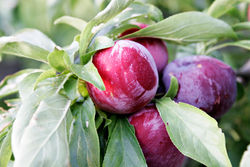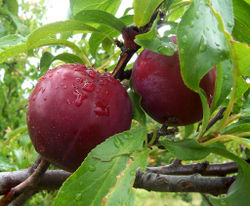Plum
2007 Schools Wikipedia Selection. Related subjects: Food and agriculture; Plants
- "Plum" is also a nickname for British humorist P.G. Wodehouse, cricketer Sir Pelham Warner and British-born fashion writer and novelist Victoria "Plum" Sykes.
| iPlum | ||||||||||||||||
|---|---|---|---|---|---|---|---|---|---|---|---|---|---|---|---|---|
 Plums
|
||||||||||||||||
| Scientific classification | ||||||||||||||||
|
||||||||||||||||
|
|
||||||||||||||||
|
See text. |
| Plums (without pit) Nutritional value per 100 g |
||||||||||
|---|---|---|---|---|---|---|---|---|---|---|
| Energy 50 kcal 190 kJ | ||||||||||
|
||||||||||
| Percentages are relative to US recommendations for adults. Source: USDA Nutrient database |
||||||||||
A plum or gage is a stone fruit tree in the genus Prunus, subgenus Prunus. The subgenus is distinguished from other subgenera ( peaches, cherries, bird cherries, etc) in the shoots having a terminal bud and the side buds solitary (not clustered), the flowers being grouped 1-5 together on short stems, and the fruit having a groove running down one side, and a smooth stone. The subgenus is divided into three sections:
- Sect. Prunus (Old World plums). Leaves in bud rolled inwards; flowers 1-3 together; fruit smooth, often wax-bloomed.
- P. cerasifera
- P. cocomilia
- P. consociiflora
- P. domestica
- P. salicina
- P. simonii
- P. spinosa
- Sect. Prunocerasus (New World plums). Leaves in bud folded inwards; flowers 3-5 together; fruit smooth, often wax-bloomed.
- P. alleghaniensis
- P. americana
- P. angustifolia
- P. hortulana
- P. maritima
- P. mexicana
- P. nigra
- P. orthosepala
- P. subcordata
- Sect. Armeniaca (Apricots). Leaves in bud rolled inwards; flowers very short-stalked; fruit velvety. Treated as a distinct subgenus by some authors.
- P. armeniaca
- P. brigantina
- P. mume
- P. sibirica
Cultivation and uses
Plum fruit is sweet, juicy and edible, and it can be eaten fresh or used in jam-making or other recipes. Plum juice can be fermented into plum wine; when distilled, this produces a brandy known in Eastern Europe as Slivovitz. Dried plums are known as prunes. Prunes are sweet and juicy. They also contain several antioxidants that may slow aging.
Prune marketers in the United States have, in recent years, begun marketing their product as "dried plums", because "prune" has negative connotations connected with elderly people suffering from constipation.
Various flavours of dried plum are available in Southeast Asia and specialty stores worldwide. They tend to be much drier than the standard prune. Cream, Ginsing, Spicy, and Salty are among the common variety flavours. Licorice is generally used to intensify the flavour of these plums and is used to make salty plum drinks and toppings for Shaved Ice or baobing.
Pickled plums are another type of preserve available in Asia and international specialty stores. The Japanese variety, called umeboshi, is often used for rice balls, called "Onigiri" or "Omusubi".
Prune kernel oil is made from the fleshy inner part of the pit of the plum.
Plums come in a wide variety of colours and sizes. Some are much firmer-fleshed than others and some have yellow, white, green or red flesh, with equally varying skin colour.
Plums and prunes are known for their laxative effect. This effect has been attributed to various compounds present in the fruits, such as dietary fibre, sorbitol, and isatin. Prunes and prune juice are often used to help regulate the functioning of the digestive system.
Plum cultivars in use today include:
- Damson, or Damask Plum
- Greengage, or greengage plum (firm, green flesh and skin even when ripe)
- Mirabelle (a dark yellow plum predominantly grown in northeast France)
- Satsuma plum (firm red flesh with a red skin)
- Golden or yellowgage plum (like the greengage, but yellow)
When it flowers in the early spring, a plum tree will be covered in blossom, and in a good year approximately 50% of the flowers will be pollinated and become plums. Flowering starts after 80 growing degree days.
If the weather is too dry the plums will not develop past a certain stage, but will fall from the tree while still tiny green buds, and if it is unseasonably wet or if the plums are not harvested as soon as they are ripe, the fruit may develop a fungal condition called brown rot. Brown rot is not toxic, and very small affected areas can be cut out of the fruit, but unless the rot is caught immediately the fruit will no longer be edible. Plum is used as a food plant by the larvae of some Lepidoptera including November Moth, Willow Beauty and Short-cloaked Moth.
The plum ( Serbian: шљива / šljiva) and the alcoholic drink slivovitz ( Serbian: шљивовица / šljivovica) are both very popular in Serbia, where plum production averages 424,300 tonnes per year; FAO 1991–2001.
The mei blossom (Prunus mume), along with the peony, are considered traditional floral emblems of China. In June 21, 1964, the Executive Yuan of the Republic of China officially designated the mei blossom to be its national flower, with the triple grouping of stamens (one long and two short) representing the Three Principles of the People and the five petals symbolizing the five branches of the ROC government . The designation, repeats a previous statement by the ROC government in 1929 .
In Taiwan the plum has been increasingly used as the national emblem of the Republic of China, as the 12-ray sun originated from the Kuomintang party flag.
The mei blossom is also the floral symbol of the ancient Chinese city Nanjing, which served as the former capital (and remained designated as the official capital) of the Republic of China.
|
Prunus domestica |
Prunus domestica |
||












